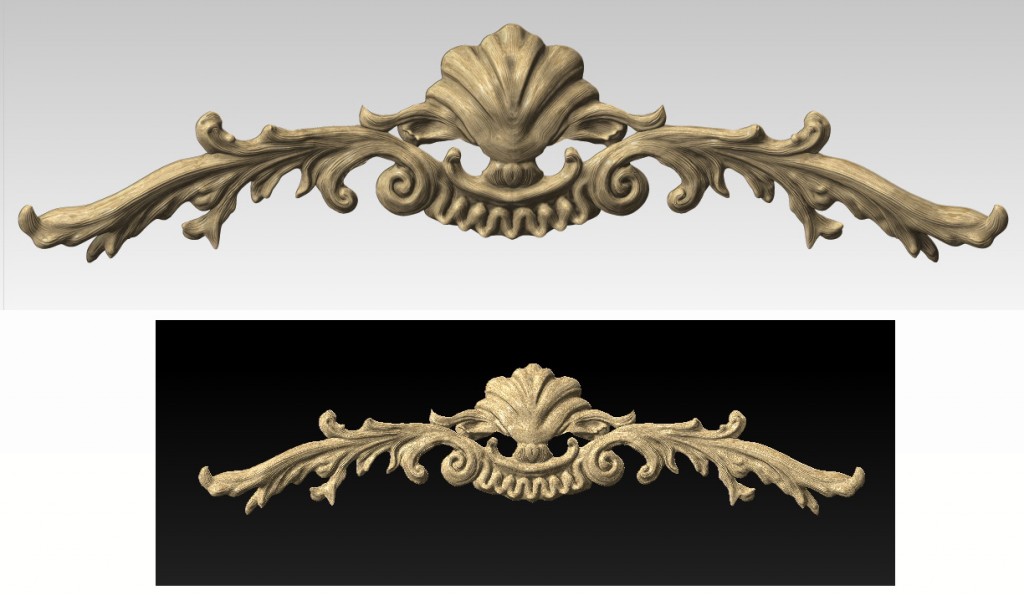New Article- A Review of New Technology for the Traditional Studio at the Siggraph Convention
New Article- A Review of New Technology for the Traditional Studio at the Siggraph Convention
Best of Artists and Artisans finally got my new article up. Check it out.
The snail mail section is so funny. This article was complete a while ago and I am thrilled to be able to share more information in the near future concerning some of my other finding on technology in the traditional studio.
A Review of New Technology For The Traditional Studio at the SIGGRAPH Convention
Writings by Ms. Mongeon
Created for Best of Artists and Artisans web site
By Bridgette Mongeon © 2008

Using technology in a traditional art studio can, at first, feel like cheating or it may bring a fear that the technology can somehow overtake the craft and creativity. I mentioned these fears and my introduction to this topic in a recent article titled Exploring Digital Technologies as Applied to Traditional Sculpting– Sculpture Review Winter 2007. In the article, I explored incorporating digital scanning and milling in the traditional sculpting studio. My research alleviated my original concerns and fears as I realized that digital enlargement, though a little intimidating at first, can be combined with traditional techniques offering another tool to use in my creative process, a tool that has the added benefit of providing me with more time to create.
I continued my research into utilizing technology in the traditional art studio while attending the 2008 Siggraph Convention this past August. Siggraph is short for Special Interest Group on Graphics and Interactive Techniques.
I once considered Siggraph as a convention for those working in graphics since it relates to illustration or computer generated special affects for movies. I have watched with curiosity over the years as the technology that has been introduced at Siggraph has infiltrated the 3D world outside the computer and into traditional sculpture studio. Those at Siggraph also seemed to be embracing the idea of bringing technology into the art studio. Three prime areas, besides the main floor of exhibitors, displayed this same exploration.
THE STUDIO
The Studio section hosted six established and emerging resident artists, along with hands on participation for learning and creating in 2d, 3d, and 4d (fourth dimension is time.) Though The Studio contained quite a bit of resources, two visiting artists captured my attention.
Matt Shlian calls himself a paper engineer, creating elaborate sculptures through the use of folded paper, which is not to be confused with true origami because he cuts and glues. My intrigue with the art was that many of the forms generate movement, changing shape with the interaction of the viewer.
It is interesting to point out that many of the artists I researched who were working with technology in their art also crossed over into the area of science. A segment of Matt’s website states this.

“As a paper engineer my work is rooted in print media, book arts and commercial design. Beginning with an initial fold, a single action causes a transfer of energy to subsequent folds, which ultimately manifest in drawings and three-dimensional forms. I use my engineering skills to create kinetic sculpture, which have lead to collaborations with scientists at the University of Michigan. We work on the nanoscale, translating paper structures to micro origami. Our investigations extend to visualizing cellular division and solar cell development. Researchers see paper engineering as a metaphor for scientific principals; I see their inquiry as basis for artistic inspiration.”
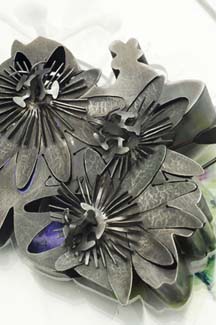
Another person that caught my eye was metal smith and jeweler, Sondra Sherman. I told Sondra that my goal as media at Siggraph was to find artists who were bringing technology into their studio, and she made sure that I knew that her present designs were created by hand, but that learning about the technology that would apply to her art studio was also her goal while at Siggraph. “I believe artists in craft media are always curious about means or materials which might enhance or facilitate their creative expression and which seduces the viewer to engage with the work. I am not interested in the ‘novelty for its own sake’ quality, which the use of technology might bring to my artwork. I am interested in how I might use the attention given to novel forms/materials to attract the viewer to consider what I might be trying to express with that form, as they would with work created in any media or by any means.”
SLOW ART
Slow Art was a juried exhibition. Artists were asked to “reconsider the paradigm of speed and instead consider the concept of “slow art.”’ The questions that were raised— how do you employ speed afforded by technology, how does it affect the work, and the process of creating slow art?
There were a variety of pieces of art in this section that peeked my interest. One of mention was an interactive piece that is the literal description of slow, titled —RealSnailMail. In this exhibit you send an e-mail on a designated computer in the slow art exhibit. It is then sent to a server in the UK. Here the e-mail is in a holding pattern along with the many other e-mails as it waits for a snail equipped with a transmitter in a tank at Bournemouth University, UK, to slide into range of a hot spot that can pick up your message. It then must move to another area of the tank to send it.
I could not help but wonder just how long my snail mail would take to get to a person. I emailed Bournemouth University in the UK using the regular fast e-mail and they quickly replied. “We have done a bit of calculating this morning. As of the 8th of Sept. 2008 we have 8,977 emails waiting. Based on this, if you sent an email today, it would take 24 years, 217 days before it gets to the front of the queue. It then may take a further 69.87 days (average snail transfer time) before being forwarded to its final destination. Therefore, a RealSnailMail sent today should arrive approximately by Thursday 16th of June 2033. Please note times may differ dependent on snail behavior and usage.” Now I am wondering how many people will have their same e-mail address twenty-four years from now.
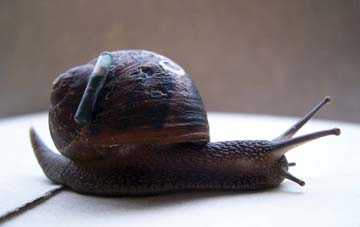
Interaction seemed to be the theme through the entire Siggraph convention. The question was, which sense was going to be stimulated or interacted with, by the art or new technology? Another one of my favorites in the Slow Art integrated vision, touch, and sound. Joo Youn Paek’s Fold Loud was a visual of large sections of tapestry incorporating origami shapes that could be folded, and in doing so, they opened circuits made of conductive material creating harmonic vocal sound.
It was difficult to truly appreciate the Taoist principles intended with this soothing art while standing in a noisy convention hall, and I was glad to see you could hear the work by visiting the Fold Loud website. I loved the opportunity to interact and touch the sculpture and while doing so to also create my own meditation.
DESIGN AND COMPUTATION
The third area depicting art and technology was the Design and Computation section of Siggraph. Here artists, designers, architects, and mathematicians created artwork, images and structures utilizing technology in both design and digital fabrication.
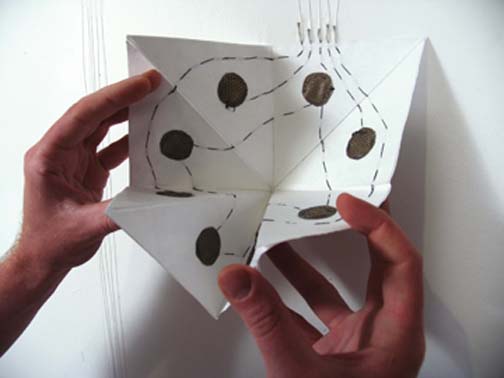
I had many favorites. The two pieces I choose to focus on were not figurative at all but instead were once again patterns and shapes.
It might seem strange to see the work of a traditional veteran sculpture like Erwin Hauer in the technology exhibit at Siggraph. Hauer created works of modernism that began in 1950 and can be found, not only in museums and collections but also in architecture. The patterns in Hauer’s work held the same intrigue that Shlians paper cutting held for me in The Studio section of Siggraph. Each modular constructivism sculpture of looping forms change as the viewer interacts with the piece, light bouncing off form, shadows moving and blending, creating an entirely different piece of artwork from every angle.
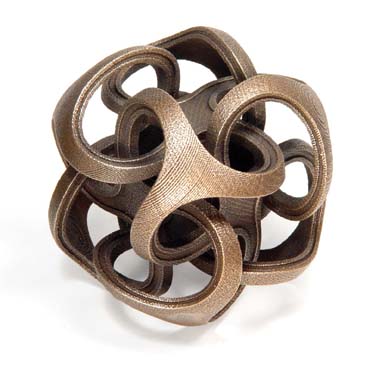
A book of Hauer’s work titled CONTINUA was published in 2004, but it is said that by that time of publishing many of the existing screens had disappeared or were in disrepair, and the laborious task of making molds and casting these screens had not taken place in nearly 40 years. In 2003 computer technologist Enrique Rosado began working with Hauer creating digital files of Hauer’s original work, CONTINUA. Utilizing the new technology of digital files and Computer Numerically Controlled (CNC) milling machines, the team is working to recreate the works of this master.
The journey of translating the designs into the new technology was not easy for Rosado. He found what I have found in my research; often you must push the technology to do what you need it to do, and then wait until it can catch up and become affordable. In a wonderful magazine article about Hauer’s work in Metropolimag.com it states, “These subtleties of balance and proportion were difficult to translate into the software. ‘The computer wants to do what it wants to do,’ Rosado says. ‘And if you’re fastidious, you really have to beat it into submission.”’
My other choice in Design and Computation was actually a student of Hauer. Bathsheba Grossman says that she was an undergraduate at Yale studying math when she first saw Hauer’s work. It was life changing; this is what she wanted to do. After graduating with a degree in math she went on to study sculpture at University of Pennsyvania. Bathsheba transfers math and science into wonderful sculptures utilizes 3D printing in metal and 3D laser etching as the output. She reports that her “traditional” studio has been reduced drastically, as she creates most of her work in the computer. It is because the complexity of her work cannot really be done any other way. She creates in a space that is inaccessible to traditional forms. Immersed in technology, for years she has watched as some traditional artists like jewelers begin to gravitate to working on screen instead of through tiny loops. It is not without its sacrifice, as she admits there is a tactile experience that is the reward of creating manually.

She waits patiently for technology to catch up to her needs as an artist. I learned that the “rough” texture created in the very intriguing process of digital printing in metal is a result of the technology and not part of her design. She is waiting for technology to improve. For those artists pursuing technology in the studio, it may sometimes feel like it progresses at the pace of RealSnailMail.
There were many more discoveries that I have found at Siggraph, which I hope to share in this column in the coming months, along with some wonderful tutorials on the advances in digital technologies as it pertains to the traditional artist. I myself have decided to embrace the technology and share it with as many creative people as I know. Maybe this will increase the snail’s pace and create the demand for the advances in technology that will assist us in our future creations. Though technology is improving and it will help us; in closing I would like to leave you with a quote from Hauer,
“It is an important token reminder for the younger generation and their tutors, that above and beyond the abundance of electronic marvels, the human vision and imagination remains the most important element and that its nurture should not be replaced by excessive reliance on devices.”
Press Release- Buffalo New York
FOR IMMEDIATE RELEASE
August 2, 2015

Former area artist involves Buffalo in a curious adventure celebrating Alice in Wonderland’s 150th Anniversary.
This year the world celebrates the 150th anniversary of Lewis Carroll’s Alice in Wonderland. Sculptor Bridgette Mongeon, a former area resident of North Tonawanda and Kenmore, has cause to celebrate as the artist’s notoriety is growing with Alice.
Bridgette is known for her bronzes of children, and her sculptures of such entertainers as B. B. King, Willie Nelson and Bill Monroe. Over the years, her work has gotten bigger. She has been commissioned to create school mascots such as the larger than life Prairie View Panther for Prairie View A & M Texas, and a fifteen-foot tiger for Grambling State University, Grambling Louisiana. Her work has also been a bit “out of this world” as she will be creating a sculpture of Neil Armstrong as a gift to Russia. Bridgette states that her newest commission of a monumental sculpture of the Mad Hatter’s Tea Party is the most curiously creative and wonderful adventure of all.
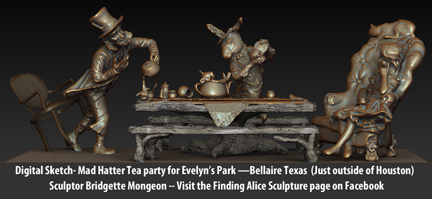
To see a larger image, click on photograph.
Tea party for eight- no reservations necessary! The Jerry and Maury Rubenstein Foundation commissioned the sculpture, in honor of their mother, Evelyn. The scene will be a larger than life size bronze that the Bridgette will install at Evelyn’s Park in Bellaire, Texas just outside of Houston.
Bridgette uses both traditional sculpture and digital processes to create her artwork. She has dual cause to celebrate as she is also debuting her new book, “3D Technology in Fine Art and Craft: Exploring 3D Printing, Scanning, Sculpting and Milling”. The book is a number one new release on Amazon and is coming out Sept 2015. In this book, she describes the digital and traditional processes that she and other artists all over the world are using in their art. She will incorporate these same processes in her sculpture of The Mad Hatter Scene. You could say that Alice no longer needs mushrooms or cake to grow. In Bridgette’s Wonderland, Alice and her friends change size digitally using such things as the Next Engine 3D laser scanner, and digital sculpting programs such as Zbrush. These tools helped her obtain a digital model that she sent to vendors who milled the art with a Computer Numerically Controlled (CNC) milling machines. Alice and her friends got big as they were milled in foam to eight feet tall. The artist then carves on the large foam pieces, and the ten-foot table, adding fine layer of clay and more detail before making molds that will be shipped to Shidoni Foundry in New Mexico for bronze casting. The installation and unveiling of this sculpture in Evelyn’s Park is scheduled for late 2016.
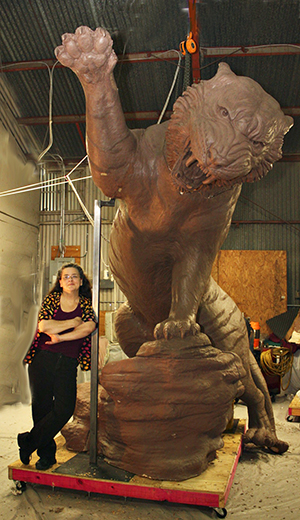
information about incorporating 3D
technology in the traditional sculpture studio.
Bridgette titled the sculpture, “Move One Place On.” The title is what the Mad Hatter beckons at the tea party. She hopes visitors will develop a tradition of shouting the proclamation and change places at the bronze table as they visit the sculpture.
Bridgette is as passionate about education and literature as she is about sculpting, writing, and technology. “I love inspiring others.” States Mongeon. She is writing a new book documenting her process of using fine art and technology with Alice and her friends.
On September 30th, she will be inspiring the youth of Kenmore West as she visits her high school to speak to the students about the combination of art, literature, technology, math and science. She will also invite some of the students down the rabbit hole. She 3D scanned her grandmother’s (Tekla Shipman from North Tonawanda) antique teacups using a laser scanner. Then she sent the digital file of a teacup to the students of Kenmore West. Kenmore West’s art teacher David Rogalski will help the students to enhance the flowers on the teacup digitally using a digital sculpting program called Mudbox. Members of the maker space, The Buffalo Lab have volunteered to help the students if they need assistance in enhance the teacup before it is 3D printed. Upon completion, the students will send their collaborative artwork to Bridgette at her Texas studio, and she will add their cup to the tea party scene before she casts the sculpture in bronze. Mongeon loves the idea that the kids can feel like they played a part in this bronze sculpture.
The Texas sculpture will have even more connections to the Buffalo area. A friend of Bridgette’s posed for the body of the Mad Hatter, but Bridgette will pull from the reference photographs in memory of a beloved family member. Her former brother in law Jack Rzadkiewicz of Buffalo will be her inspiration for the Hatter.
In honor of the sesquicentennial, Mongeon is also creating, and hiding 150 different elements within the scene, inviting park visitors on an interactive journey. If you arrive at the sculpture with your lunch and the best dinning experience is occupied you can begin the treasure hunt searching for the 150 elements. For example, if guests look carefully, they may find a small Humpty Dumpty hiding, and the waiting White Queen tucked into the bronze “bark” legs of the table and benches. (Note the face of the waiting white queen is in memory of another Buffalonian- the artist’s mother, Barbara Ingersoll.) The sculpture and Evelyn’s Park, located in Bellaire, will be a “destination spot” for visitors to the Houston area. Lewis Carroll fans worldwide will come to experience the endearing story of Alice in Wonderland.

Besides her inspirational presentation at Kenmore west, Bridgette will be speaking at Penn State Behrand, and then returning to the Buffalo area. The Buffalo Lab Maker space in The Foundry will host a lecture by the artist. There she will show her work, the new book and the Alice in Wonderland project. The lab will also have some demonstrations of the 3D printing process and tours of their facility. Join her on the curious adventure Thursday October 1st at the 7:00 pm. The Buffalo Lab is located at 298 Northampton St, Buffalo NY 14208 inside The Foundry.
You can follow the project of creating Alice on the artist’s blog at http://www.creativescupture.com/blog or at the finding Alice Facebook page.
–For more information about this press release contact Bridgette Mongeon 713-540-3201
Bridgette@creativesculpture.com
–Watch this YouTube Video to see the sculpture and process https://www.youtube.com/watch?v=P1J821vwkr8
–For information about Evelyn’s Park http://evelynspark.org/
–Evelyn’s Park press release
___________________________
Interview Questions
How long have you been an artist?
Ever since I could pick up a crayon. My first commission was at Grant School in North Tonawanda. I was in kindergarten; the teacher gave me the hall bulletin board to create a scene of Santa and reindeers. It was tremendous pressure because I wasn’t sure I could draw a reindeer from memory. The teacher found the reference for me to work from which confused m. If she had pictures of reindeers, why did she need me? I write about this experience a lot.
Where did you live in Buffalo?
We moved around quite a bit. I lived in North Tonawanda in the Herschell home owned by the family that built the carousels. I loved that old house. We lived in Tonawanda for a short time, Grand Island, Kenmore and the West Side of Buffalo.
Where do you live now?
I live in Houston, Texas.
Do you still have family in Buffalo?
My parents have both passed away. I have several cousins and immediate family in the area. I have a sister, Becky Gillen in Grand Island and Bill Mongeon lives in Gasport. I have two nieces Rachel Dluhy and Kate Rzadkiewicz. I’m coming to Buffalo for Kate’s wedding, so I guess she will be Kate Fogelsonger. She is the daughter of Jack —my inspiration for the Mad Hatter.
When you lived in Buffalo, did you receive inspiration in your career?
Oh, my word yes! The novels I am working on are full of experiences from my childhood.
My first introduction to art was through my teachers at every level. I am eternally thankful for their dedication. I mention that in my dedication of the book.
The Albright-Knox art gallery gave me something for which to aspire.
But, it was more than just the art galleries. It was Delaware Park, and the richness of the woods and streams surrounding this area, and the cemeteries- especially Forest Lawn Cemetery near Delaware Park. I try to visit there every time I come home. I’m a nut about cemeteries, and Forest Lawn has a piece by one of my favorite sculptors—Harriet Frishmuth.
The Seaward Johnson sculpture of the newspaper reader on Niagara Street probably influenced my career as an artist. That is exactly the type of work that I love to create— bronzes that interact with the community. The Mad Hatter Tea Party at Evelyn’s Park has that in spades, or should I say “hearts.” Oh, how I wish I could receive a commission to create something like that for the Buffalo area.
In your art education in Buffalo, did any one teacher stand out?
Absolutely! Debbie Lloyd was my teacher at Kenmore West. She went over and above the call of an art teacher. She helped me through some very difficult times and in the end, we became very close friends. I love her dearly and have her in my book dedication.
You are not necessarily an educator, but education seems to be important in what you do.
Yes, it is. I love the opportunity of helping others to reach their goals. I’m obsessed with sharing information and in creating community. Those things seem to drive everything that I do. I love that I can educate through my speaking engagements, writings and podcasts.
I also want to work with an art mentoring program. I looked and could not find one. So, I created my own. I’m presently mentoring a young man. I would love to be involved in a progressive education art mentoring program. I’m sure I could do it through distance learning. If there is anyone who is interested, please let me know.
I was thrilled to be a part of 3DCAMP Houston as the cochairwoman for two years. It was a tremendous amount of work, but it was great. I helped in education, developed community and gathered resource for my book.
What started you into 3D technology?
I was married, and my husband was doing 3D graphics as a medical illustrator. He brought me to many conventions that introduced me to the technology. I kept my eye on it and wrote about the technology for Sculpture Review in 2007. Soon after, I developed a graduate degree around 3D Technology in Fine art.
Another thing that pushed me to 3D technology was an injury. Artists like dancers, require their bodies to create their work. Bruce Beasley, a well-known sculptor, describes it in my book as “dancers bodies”. We injure ourselves through the very thing we love. About five years ago, after many years of pushing around clay, I developed some pretty good Popeye forearms. However, I lost all the use of my right hand, I had surgery and am very careful, still doing massage, therapy and use my interns for repetitive work, but when it happened I thought my career was over. That is when I fully embraced 3D technology into my own work.
When sitting on a panel last month, “Hand vs. Computer” at the National Sculpture Society meeting in Philadelphia, I met an artist who had a stroke. He said he was interested in my book because he hoped he could one day create again. I wept. Because of my temporary loss, our encounter was a very personal experience.
Should my career keep going in the direction that it is, I have considered being involved in a scholarship program. I would love to create something for young artist/writers/musicians, especially ones with personal difficulties.
Do you work alone?
Sometimes, but with a project like Alice or the Grambling Tiger, I will find interns from the neighboring schools, high schools, and colleges. We can have up to 10 people working on a project that come and go throughout the week depending on their schedules. I long to have one young artist that I could nurture and would then work for me full time. I do have an intern that has worked with me on quite a few projects. Allison Gonzalez is not a sculptor, but she is the best “rusty right arm” any artist could hope for. I also long for an office assistant- with all I do I need someone to keep me straight. Until then… I have an imaginary assistant named Elizabeth.
Podcasts? You mentioned podcasts, what are they and where do people find them?
Well, I have been podcasting for years. I love it, though it is time-consuming, especially the editing.
INSPIRATION GENERATIONS
I started podcasting years ago with the Inspirations Generations Podcast. I podcasted with my daughter and mom “Three Generations of Christian Women.” Mom sat on the phone in her assisted living facility in Amherst. She had a powerful spiritual ministry helping hurting women throughout Western New York area, but when her body turned against her, she spent most of her time in a chair or bed. My daughter, Christina Sizemore, who lived in Oklahoma at the time, would call, and we would talk about different things, mostly of a spiritual nature. That interaction gave my mother a purpose in her last days. We did that for nearly three years. I am so thankful I did this. I can listen to my mom, anytime I want, though many of the podcasts were not just with mom. Her health would not permit it. So we podcasted with others like Billy Grahams daughter Ruth Graham, the figure skater Scott Hamilton, a monk in Taize France and numerous authors, comedians, etc. The podcast can be found on iTunes and on my gift collectibles webpage at godsword.net.
ART AND TECHNOLOGY PODCASTS
In the last year I revived the Art and Technology podcasts that I started during my graduate degree. I now interview the artists and vendors from around the world that I have featured in my book, and who are pushing the limits of the technology. These podcasts can be found on ITunes and on the book’s website at www.digitalsculpting.net
You mentioned novels. So, you write more than nonfiction?
Yes. I probably have about seven books that I am writing at any one time. What makes it difficult is that they are all different genres. I’m very diverse. I love writing young adult and middle grade. I have a few books in the works; they are highly reflective of my childhood in Western New York. Another novel that is complete is about a young girl whose mother sculpts deceased loved ones, and the strange occurrences that happen surrounding that. I base this story on a lot of my experiences of sculpting the deceased. That is another area that I am known for. I love helping people with their grief through my art. I also wrote a nonfiction book on the strange things that happen when I am sculpting deceased loved ones that include the science, empathy, and emotion of the process. It is a fascinating subject, and I have also lectured on from time to time.
I also have a few children’s books I have written. I’d love to do more of those now that I am a grandmother. My biggest hindrance in getting these published is that I detest looking for publishers. With all of my diversity, I could spend a great deal of time tracking down the right publishers. I desperately need an agent that is diverse in the publishing field.
Many people ask me if I would consider self-publishing. I love the idea, but my books are stolen from the Internet weekly. I love the freedom of copying the link and sending it to my editor to get it to their legal department. I’d go broke tracking these down myself.
I love helping other artist/writers/and musicians market their work and have written about this throughout my career and speak on it whenever possible. I decided to pull from some of those writings and create a book that is a series of essays. This idea was sparked recently by the death of B. B. King. I realized it had been nearly 30 years since I sculpted him and he gave me my start as an artist, calling me his “personal sculptor.” I needed to record these adventures along with some of my epiphanies in my creative life. I’m excited to be working on that project—in my spare time.
What books have you written?
I was coauthor on Digital Sculpting with Mudbox: Essential Tools and Techniques for Artists
with author Mike de la Flor. I contributed to Mike de la Flor’s book The Digital Biomedical Illustration Handbook (Charles River Media Graphics) and have I been a contributing author on a few other books. I have written for numerous magazines and papers on different subjects. 3D Technology in Fine Art and Craft: Exploring 3D Printing, Scanning, Sculpting and Milling is my first book going solo.
You sound very busy, what do you do for fun?
Well, I love what I do. Getting paid to play in dirt and write is extremely rewarding. I have a 2-year old granddaughter, and I love the entire experience of learning through play and exploration. However, it is extremely stimulating creatively; I want to sculpt her, paint her and write books for her.
I am a ferocious reader- and listen to audio books like most people listen to the radio.
I am a gardener, but I realized that the word “garden” is also a verb, an action. I don’t do that very much anymore, as I walk through my gardens to my studio. I spend most of my time near my pond and stream that I created in my backyard. It is a way for me to have a little of that western New York memory in my Texas backyard.
I also dance. I assist with salsa and bachata at SSQQ dance studio in Houston. When I’m not hauling around sculpture, dance is what I do 2-3 times a week for exercise. Besides, being a sculptor and writer is a lone experience. Assisting with dance is my interaction with others. Dance is my “water cooler” experience.
A writer and a sculptor, is that hard?
When I was young, I thought I had to choose one over the other. I was also singing in the chorus and played the guitar, so that made it even more difficult.
There are two muses, over the years I have learned to play them one off the other. I say, “I will be finished with this book writing and be able to get my hands dirty again. Ah, but once I do, this lover, “writing” will taunt me just as my sculpting lover is now. Yes, having an affair with another creative process can keep your creative passion on fire, but it might be less heart wrenching to be in a monogamous creative relationship. Ah writing and sculpting muse you each vie for my attention and I am blissfully and heart wrenchingly caught in between.”
I always tell students that one of the most important aspects of my career as an artist, was being able to write. I write about my work and what I know. I create press releases. It is an important skill.
What is your education?
I have always claimed Kenmore West as “My high school” even though, technically, I was only there for a few months. I was one of the kids that fell through the cracks. I left home at the age of 15. NY had a law that said you could not work past 9:00 p.m. if you were under age—stupid law. It forced me to quit school. Of all of my accomplishments, I wish I could have added graduating from Ken West to my list. Alas, I cannot, but my heart is there, and I will always be thankful for the quality adults that touched my life during that very short time. Frankly, I’m not sure I’d be alive without their help. But that is another story, one I hope to write in a novel one day.
Later, after moving to Texas, I brought my portfolio to the Community College and they accepted me into their program on my portfolio alone. I originally went into advertising and public relations, a choice that has benefited me in my career as a fine artist. I left the community college for full-time employment and soon after found sculpting. Later in life, I finished my bachelor’s degree at Vermont College. It was an unusual program as you could design your studies. It was distance degree program with a one-week residency twice a year in Vermont. I loved the progressive education, and it fit my personality perfectly. I am self-motivated to a fault. I continued with a similar program at Goddard College, also in Vermont for my Master of Fine Arts in Interdisciplinary Art (MFAIA). I had a dual focus in my MFAIA. It was important for me to receive enough credits in both areas so that I could teach, if I wanted, though my art, writing and speaking keep me busy full time. I structured my degree around 3D technology and fine art. I believe I designed one of the first degrees with this focus. The other focus of my MFAIA was creative writing.
The best part of traveling to the North East twice a year for my undergraduate and graduate programs is that I made a point to stop in Buffalo. I will forever be thankful that I had such quality time with my parents before they passed.
What is in your future?
I’ll finish the sculpting on Alice this year. The sculpture will be at the foundry for several months. Then I’ll spend a month in Santa Fe where I’ll check the metal and work with Shidoni foundry. While in Santa Fe and in between metal checks and the final patina, I’m scheduling some speaking engagements in New Mexico and Colorado. When I’m not doing either of those things, I’ll park myself in an inspirational location looking at the wonderful Santa Fe landscape, and I’ll write. I see myself doing a lot of that as I am writing two books around the Alice in Wonderland sculpture. The fist, Finding Alice- The Process is very similar to 3D technology in Fine Art and Craft: Exploring 3D Printing, Scanning, Sculpting, and Milling. However, instead of focusing on artists around the world who use the technology I will be focusing on the process of creating the sculpture “Move One Place On.”
The second book is The Finding Alice- Field Guide, it is written in rhyme and riddle. It will give hints to the 150 hidden items in the scene. I’m thrilled about writing this one, as I love writing for children, and this gives me a reason to stretch those creative muscles.
Unlike many artists who work in their studio and sell their art at art shows or in galleries, I work from commission to commission. With the incorporation of the digital technology, I can create twice as much as I could before I used that in my studio. I’m never sure what commissions are around the corner. I have a few life-size commissions pending after the completion of Alice. Though they have broken ground for the Neil Armstrong sculpture in Russia, they are still trying to raise the money. www.unitedinspace.com so that is on hold. I’m always open for new commissions. I have publicly told the town of Clarence I would redo the sculpture of Lucy, but I have not heard from them. Other than that, I’ll wait to see what comes. It is not often that an artist has such an incredible opportunity to create something like the Mad Hatter Tea party. I do hope I find another client that would love something as fanciful and fun as this project, my dream would be that this would be in Buffalo.
I hope to get over to Europe. I have been invited by the Digital Stone Project for the last two years but have had to decline as I kept thinking Alice was coming through. I write about the digital stone project in my book. It is a residency where artists stay in Tuscany for a month. They pick out marble from the stone quarry and then create art using CNC milling and a robotic arm at Garfagnana Innovazione.
In my book, I have featured so many artists and vendors from across the pond. I would love to spend a couple months, one in the Digital Stone Project residency and another traveling, speaking and seeing the incredible art I featured in the book. Besides Garfagnana Innovazione. There is Estudio Durero in Spain. They create 3D photography for the blind. Factum Arte in Madrid, is creating so much with 3D technology and fine art it would be a wonder to see it in person. There are many different companies and artists in the Netherlands such as Joris Laarman, another artist I featured in the book and who has had lots of publicity of late for his robotic 3D printing of metal and the bridge that is building itself. I’d love to get over to Austraila and see Symbiotica at the University Of Western Australia, they combine artists and scientist to create some very strange and intriguing art. I have podcasted with Oron Catts at Symbiotica and featured him in this book and other articles. There are many pioneers who have been using 3D technology in their fine art for many years. I have come to know them, long distance. I would love the opportunity to see them and perhaps share with their universities.
Do you have artwork in Buffalo?
The sculptor has publicly offered the newsboy to the Buffalo area if funds can be raised to cast and deliver the sculpture. She will donate her portion.
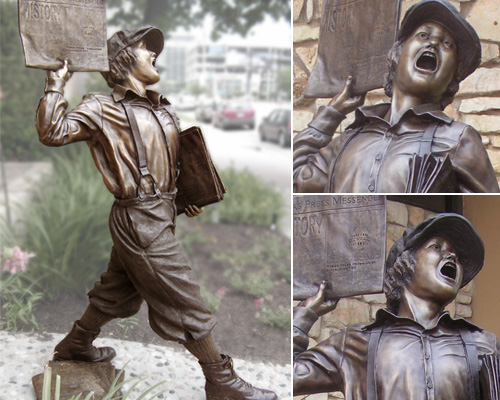
No, it is on my bucket list, and I have left instructions in my will. Of course, I would be elated to have something at the Albright-Knox. I have publicly said, on more than on occasions, that I would donate my portion of the newsboy sculpture to the area if I could find a backer to pay for casting and shipping. Maybe I should set up a Kickstarter for that. I have no idea where the sculpture would go, but I can tailor the newspaper he is hawking to depict a period in history. I’d also love to have a public piece along the Canal in North Tonawanda, since that is where I was born.
My mother is buried in Mt. Olivet Cemetery. They don’t allow sculptures in her portion of the cemetery. She is buried on St. Francis drive. I have often dreamed of creating a large sculpture of Saint Francis that would reside on Saint Francis drive or in front of this cemetery.
Maybe I’ll find an art patron or business, who loves Buffalo as much as I do, and can see the possibility of collaborating on a wonderful interactive piece for Buffalo. If you know of one, tell them I’ll clear my schedule and be ready to start in 2016.
Artist Is Searching For 3D Printer to Promote in A New Book
Bridgette Mongeon, is the author of the new book 3D Technology in Fine Art and Craft: Exploring 3D Printing, Scanning, Sculpting and Milling – Focal Press Sept 2015 and the host of the Art and Technology Podcasts. She is embarking on a new sculpture and book project and is searching for the perfect home 3D Printer to review and promote in the book and in the creation of a high profile monumental sculpture.
The sculpture is a monumental bronze of Alice In Wonderland’s Mad Hatter tea party. July 4th 2015 is the 150th anniversary of Lewis and Carroll’s story of Alice in Wonderland. The media opportunities on the project alone are monumental.
The artist is also creating a new book project associated with the monumental sculpture tentatively called Finding Alice- Incorporating 3D Technology and Traditional Sculpture in Creating a Monumental Bronze Sculpture. Finding Alice is similar to her previous book but instead focuses on one sculpting project and the technology used to create the art.
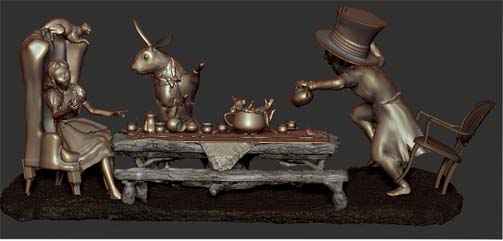
Just how is 3D printing being used in a monumental bronze sculpture? The artist is creating 150 elements that will be hidden in the bark of the sculpted bronze table, benches and nearly 20 foot scene. These items will be created using a combination of 3D scanning, sculpting and 3D Printing and then embedded into the clay before the artwork is made into a bronze.
The Duration of this Arrangement
The artist is searching for a 3D printer for the duration of the sculpting of the project which is approximately 12 months. The printer will need to be available March 2015 and preferably come pre assembled, unless there is someone in the Houston, Texas area that can put the printer together at no cost.
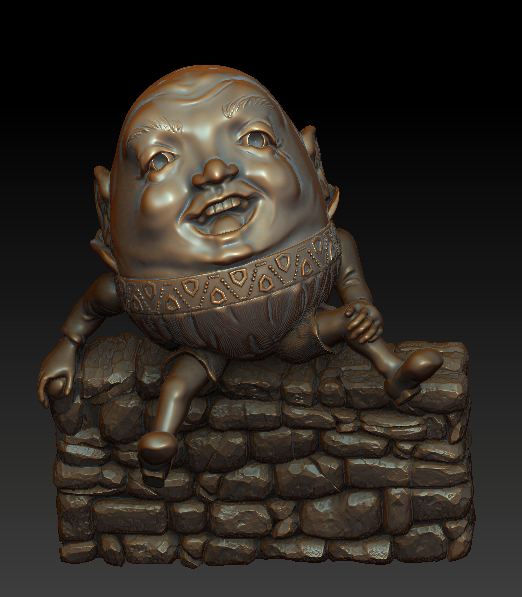
What is the artist looking for in a 3D printer?
- Good Communication with Technical Support
Creating a monumental bronze sculpture, and writing a book is not a “quick” task. That is why a clear channel of communication with the manufacturer of the 3D printer and their technical support team is essential. Reviews and tutorials need to be written and clearing a channel of communication can help the artist reach her “monumental deadline “of the sculpture project and clearly write the details of the 3D printing process.
- Ease of Use
Because the author/artist will be writing extensively about using the printer it is important that the 3D printer work properly. Of course with all technology—things happen. That is why the first criteria in this project is good communication with technical support. - Type of 3D Printer?
In writing the 3D Technology in Fine Art and Craft and creating her 3D printed artwork the artist is aware that designs need revising and often more than one 3D print is required. That is why the artist would prefer to have two 3D printers to review. One fused deposition modeling printer and another printer that uses stereolithography. With the stereolithography printer it is especially beneficial if the 3D printer also use castable resin for further experiments and promotion. - Great Resolution Each of the 3D printed pieces will be embedded into the clay. The deadline to complete this project is tight and therefore the best resolution with the least amount of post processing is preferred.
The Promotion Opportunities
- Inclusion in Mongeon’s book Finding Alice
- Inclusion in the media press that features the combination of new technology with age old sculpting for creating this legacy of a story.
- Possible inclusion in the next edition of 3D Technology in Fine Art and Craft—if the publisher Focal Press requests a follow up edition.
- Inclusion and mention on Ms Mongeon’s book tour- Providers of the 3D printers are welcome to supply their own printed collateral material for distribution. Mongeon is scheduling a book tour with universities, maker spaces and communities dealing with 3D Technology. She is a returning speaker at 3D Printer World Expo, was the cochair of 3D Camp 2012-2013 and is involved in the educational initiative of STEAM which encourages the combination of Science, Technology, Engineering, Art and Math in education.
- Add space on the book’s accompanying website.
- A podcast episode with the host of the Art and Technology Podcast featuring the companies 3D printer and artist that use it.
If you are interested in this arrangement please contact the artist through the contact form on her website.
Other information about Bridgette Mongeon
FINE ART/WRITING/SPEAKING
Sculptor’s fine art website
BOOKS
Digital Sculpting With Mudbox: Essential Tools and Techniques for Artists.
NEW BOOK
3D Technology in Fine Art and Craft: Exploration of 3D Printing, Scanning, Sculpting and Milling. Sept 2015
Join the conversation and share your own work on 3D Technology and Fine Art on LinkeIn
Join the conversation and share your own work on 3D Technology and Fine Art on Facebook
ART AND TECHNOLOGY
Art and Technology Podcast
Inspiring Young Minds in Fine art and 3D Technology
Carol Andrews, Visual Arts Director Newspring Center in Spring Branch Texas, invited sculptor Bridgette Mongeon to speak at North Brook High School. New Spring Center and Mongeon have the same desire- inspire young minds to “define and achieve a bright economic future. A few different classes joined in for a creative and visually stimulating lecture by Mongeon. The facilitating teacher Scott Keairnes asked Newspring to find a sculptor to speak to the students, what he got was a bit more.
Mongeon is a well-known bronze sculptor has just finished writing a book titled “3D Technology in Fine Art and Craft: Exploring 3D Printing, Scanning, Sculpting and Milling.” She has been combining 3D technology in fine art for years and enjoyed talking to young people about the many different aspects of 3D. “A student who learns about 3D, whether it be 3D scanning, 3D printing or even 3D sculpting and Computer Numerically Controlled Milling, will find that their education is crosses disciplines. They can take these tools and use them in multiple different ways. The young people that embrace and learn this technology will put themselves ahead of others when it comes to looking for a job. The

government is also seeing the importance of the technology and is investing, exploring and supporting education in 3D. I’m thrilled for the opportunity to inspire the students,” states Mongeon.
The artist talked about a variety of subjects other than just fine art and technology. Architecture, science, and medicine and other disciplines use 3D technology.
“I want to encourage the students to understand that using their art as a career does not just mean being a studio artist. This is something I did not grasp in high school. There are a variety of careers that use the arts, and even more that incorporate 3D technology.” A variety of subjects other than just fine art and technology. Architecture, science, and medicine and other disciplines use 3D technology
The sculptor also announced that she uses interns at her studio on a regular basis. “ I love mentoring young people. Give me someone with a passion, and I can teach them the art. Internships are some of the best ways for young artists to get ahead.” Find someone who is doing what you think you might like to do and ask them how you can help. Tell them you will take out their trash if necessary. You just want to be in that environment.” Mongeon ends the lecture with a motivational conversation that she uses in many of her lectures when she teaches marketing in the arts. “There is something in the adage of ‘it is not what you know, but who you know.’ You may think that because you are young that is harder, but it gives you an advantage. She shares a story bout a girl who planned for her pony. She closes with the statement, ‘Plan for your Pony and you will become known by all of the pony keepers.'”
At the end of the session, one student out of the many approached the artist and asked, “how do I learn about an internship? This is the motivation the artist seeks. “ I have used interns for many of my projects over the last several years.” States Mongeon. “ The students are always changing; I would love to find that one passionate person who would be interested in making a career out of art. Someone that is dependable and a good worker and that I could work with for many years to come. I’ll still use other students, but I am open to finding that one special person.”
“When the book comes out I would like to create a book tour. I’ll be looking at other high schools and higher education to lecture at next year. I’m thrilled with the possibility of this book becoming a resource for inspiration and education of so many in the different disciplines that incorporate the arts and technology.“
Mongeon’s book 3D Technology in Fine Art and Craft: Exploring 3D Printing, Scanning, Sculpting and Milling will be coming out June 2015. The artist is thrilled that those reviewing the book have found it to be a good resource as a text book.
“Bridgette Mongeon has taken the complex subject of 3D printing and made its secrets available in clear readable form for the artist and the public. She has given the reader the most up to date and useful information along with the necessary little secrets to make the appropriate decisions in applying this new medium to the art of making sculptural forms. It is an informative and enjoyable book from start to finish. Her choice in examples gives the viewer some of the most contemporary sculptural works available. An excellent textbook for every level.”
Mary Visser, Professor of Art, Holder of the Herman Brown Chair
The Sarofim School of Fine Arts
Southwestern University
“This is a much needed comprehensive introduction to “state of the art” digital sculpture. The author is a professional sculptor whose practice bridges a wide range of traditional and contemporary, analogue and digital, approaches to creating and realising her work. With an extensive knowledge, experience, and understanding of her discipline, its history and current applications, she is ideally placed to impart of this knowledge to anyone with an interest in digital fine art sculpture. The text and illustrations are clear and instructive, taking the reader on a step- by-step journey through otherwise difficult to navigate technologies. Between its pages this publication covers a wide range of digital tools currently in use by fine artist and craftspeople. It does much to dispel a lot of the smoke and magic surrounding the technology, demystifying this in an easy to follow account of the pros and cons in all of the categories covered. Each chapter in turn offers an in-depth explanation of its topic, written with the first-time user in mind it is also an invaluable resource for the professional sculptor and educator….a must for anyone with an interest in 3D digital creation and fabrication.
Keith Brown
Director of Art & Computing Technologies
Manchester Metropolitan University
Manchester Institute for Research & Innovation in Art & Design”
3D Technology and Fine Art — A New Book
I have been working on a book for quite some time now. My editor at Focal Press tells me that ten months is record time for creating a book like this. It feels like an eternity for me. Today it goes to the publisher. The proposed design by Diliberto Photo and Design is featured on this page.
The book focuses on the combination of 3D technology as it pertains to fine art and craft. The constant within the book is of course, realizing artwork in a physical form. I have been so excited to feature the work and practices of many artists, nearly 90 something artists at last count. What is different about this book and the accompanying podcasts that are being recorded with the artists is that they tell their tips and tricks. I have always been a “show me” person. Show me what you did, how you did it and let me bring my own creativity into the process. I have said over and over about this technology , you don’t know what you can do until you know what you can do and once you realize what is possible it will blow your mind.
I think it is important to focus on all three aspects of the book. They inform each other. 3D Scanning is important because it offers so much to a traditional artists and digital artist alike. 3D printing is all the rage, but how can we push the limits to create unique and original art? CNC Or Computer Numerically Controlled creations have been around for a long time. However, you will not believe what artists are doing with this tool. Digital Sculpting lets us modify or create incredible pieces of art. The combination of these four means individuals are creating artwork that up to this point in technology, could never be created.
There is a great deal more in the book.
Now on to recreating the website for the book at http://www.DigitalSculpting.net. Digital Sculpting.net was original created for my previous book written with Mike de la flor, “Digital Sculpting with Mudbox: Essential Tools and Techniques for Artists.” This is where you will be able to find many of the references in the book and additional information. You can now find the old podcasts on the DigitalSculpting.net website. However, I’ll soon be promoting the new podcasts. I am interviewing quite a few artists and companies from the book. The podcasts are a delight and really give life to the book. I’m thrilled to have them. Wait until you hear some of the tips and tricks from these artists. Once the new podcasts are made public you will be able to use the links anywhere you like. You can even use the podcasts on your own blog.
Anyways, I hope you like the book.
Pre ordering should be available in the next few months. I am also planning on a series of lectures and book tours next year. If you are interested in having me come to your school, please feel free to contact me. I would love to come and speak.
Do you know anyone who might like to review the book? Please let me know.
Bridgette Mongeon is a sculptor, writer, illustrator and educator as well as a public speaker.
Her blog can be found at https://creativesculpture.com.
She is the vice chair of the planning committee for 3DCAMP Houston 2012 and 2013 http://www.3dcamphouston.com
Follow the artists on twitter twitter.com/Sculptorwriter
Wow, It Is Like Having An Entirely New Art Tool That Makes My Work Look Spectacular!
I have been learning Zbrush4 for a while now. Though there is so much to learn. I have to admit, I can’t spend nearly as much time with it as I like. Zbrush 4 has something called Best Preview Render. For those of you interested in checking it out there is a link to the pixologic site that shows the details.
I still must study all of the bells and whistles of this feature of Zbrush, however, I must say I am thrilled with just my few tries of this feature. For example, I am including two screen shots in this blog post. One with the render, one without. World of difference. The feature, makes me want to create. It is like pressing a button and someone coming in and making your work look great.
Now back to playing.. uhmm I mean working.
______________________________________________________________________________

-Sculptor, Writer and Speaker
Bridgette Mongeon is a sculptor, writer and educator as well as a public speaker.
Her blog can be found at https://creativesculpture.com.
She is also the owner and creator of the God’s Word Collectible Sculpture series
Follow the artists on twitter twitter.com/Sculptorwriter twitter.com/creategodsword
Facebook http://www.facebook.com/bridgette.mongeon
Listen to The Creative Christian Podcast or the Inspiration/Generation Podcast Click on Podcast Host Bios for a list of all podcasts.
Listen to the Art and Technology Podcast
New Year- Getting Organized
The new year is already around the corner and I find myself compulsively trying to get reorganized. 3 tasks sit ont he forefront of my to do list.
1. Backup Big Mac-
I have ordered a new internal hard drive for my Mac. I have encountered a failing hard drive and will be backing up items both on discs and through time machine. This job is really a housecleaning project.
2. To Do List?
I’m not real happy with the way my mac organizes my day. Or maybe it is me organizing my day. I want to set up goals and project and have a step by step way of completing them. I am a list maker and love to see things corssed off. Hubby says, “What is wrong with a notepad?” That does work to some extent but it gets messy very quickly and the pages get torn off and lost. So I’m reviewing software that will help me stay organized. The software of choice Ominfocus.
3. Novel Writing Software.
It has come to my attention that Word just is not doing what I need it to do when trying to complete or clean up a novel or book. I have about 3 book projects going at this moment. The two software programs I am looking at for this job is Storymill and Scrivener.
I guess I’m leaning toward Scrivener as everyone seems to rant and rave about it, plus instead of having just a educational discount they are offering a 50% discount for all of those who participated in National Novel Writing Month and finished. I’m proud to say ia m one of those. I’m also looking at Story Mill, as I really like their timeline feature.
I must not be the only one that really likes the timeline feature in Story Mill. As Tom Borowski says in this this comment thread on an article that compares Story Mill and Scrivener.
______________________________________________________________________________

Sculptor, Writer and Speaker
Bridgette Mongeon is a sculptor, writer and educator as well as a public speaker.
Her blog can be found at https://creativesculpture.com.
She is also the owner and creator of the God’s Word Collectible Sculpture series
Follow the artists on twitter twitter.com/Sculptorwriter twitter.com/creategodsword
Facebook http://www.facebook.com/bridgette.mongeon
Listen to The Creative Christian Podcast or the Inspiration/Generation Podcast Click on Podcast Host Bios for a list of all podcasts.
Listen to the Art and Technology Podcast
Technology in The Art Studio
Created for Best of Artists and Artisans website
By Bridgette Mongeon © 2008

CLAY
In my twenty-three years of sculpting, the process and materials have changed very little. Moving from water-based clay to a wax-based clay was probably my biggest change over the years. It was really done out of necessity. Being a commissioned sculptor, the time between starting a sculpture and a final approval could be months. Trying to keep a water-based clay portrait or a life-size figure from drying out and cracking was a nightmare and when introduced to Classic Clay (brown firm AB200) from Reynolds Advanced Materials, I made the switch. Almost all of my work is created for reproduction by either the manufacturer of my gift items or my foundry for bronze. I rarely fire sculpture in the kiln. In using Classic Clay I no longer have to keep my sculptures wet over the months of time that it takes for an approval, but having to heat up the Classic Clay, with crock pots and torches is a bit inconvenient. The studio is less dusty with the wax-based clay, than it was with water-based clay but I miss having the feel of the water based clay. Even the process of drying out, that caused me such tension, gave me that leather hard stage in the during the drying process that was perfect for adding fine texture to the sculpture.

Casting Outdoor Sculptures
I also keep my eye out for changes in technology as it pertains to casting material, especially outdoor material. Many years ago, when I cast in concrete, I was desperate for additives or different strong but lighter casting material. Whenever someone would tell me they had a product it always fell short of my expectations. Upon further research, it would not withstand the elements. it would chip or it did not come in bright white so that concrete dyes could be added. I have not poured in concrete in a while, so I do not know if anything new is on the market. Though it would be interesting to know if something is now available.
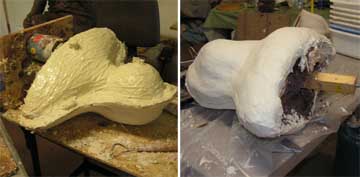
Mold Making Material
Mold making material is another area where technology is vital to my production. If someone could invent a mother mold material with the strength of fiberglass, but not the smell and toxicity, that would be great. (A mother mold is the structure that is put over a rubber mold when making a mold. The mother mold holds the rubber in place, so that when you pour something in it, it is not deformed. Usually the mother mold is plaster that is heavy or fiberglass resin that is toxic and uncomfortable to work with.)I have tried Plasti Paste, a mother mold material purchased from Reynolds Advanced Materials but personally I was not happy with the results. (photograph shows rubber mold with plaster mother mold)
I’m intrigued with the materials used in special effects and frequent the web sites of Reynolds Advanced Materials and Smooth On ( Reynolds Advanced Materials is part of Smooth On ) to see what new items they have.
I have spent some time ordering and utilizing their free dvd’s and pamphlets. The Reynolds site has an entire section on How To. I would love the free time to play with all of the fun things that can be found from these vendors. And now Smooth On has Youtube videos! Like this one on how to create a face mold.
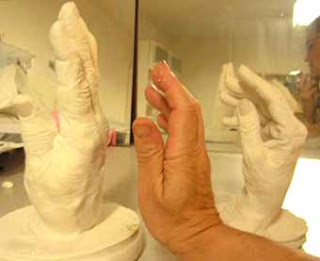
I recently utilized Smooth On’s material for casting hands, and the process that they discuss in the second YouTube video, is similar to what I did. I cast my mom and dad’s hand and they are now two of my most prized possessions. I wrote about them in my newsletter, and posted my thoughts and the process on my forum. The process was the same as the Smooth On video, though I cast their hands in plaster and the Smooth On video shows plastic. ( picture shows father’s cast, my hand, and mother’s cast)
Digital Enlarging
My most recent endeavor into new technology in the art studio has been digital scanning and enlarging. I visited Synappsys Digital Services and was intrigued by what I saw.
Before I go any further, I must first explain the process that a sculptor goes through to enlarge a sculpture. Often a client will want to see a small maquette, which the artist creates for approval by the client. Then the artist proceeds to enlarge the sculpture by creating a metal armature of pipe or rebar, foam and chicken wire. This armature gives the sculpture structure and support, and the foam offers mass that is light in weight. A final layer of clay is put over the foam and details are added. This process can take weeks. (If you would like to see the entire process of creating a life-size sculpture in this manner, please review my online journal of creating the life-size newsboy.) If a sculpture is going from maquette to monumental, the process is a monumental task!
Synappsys Digital Services, along with a few others in the country offer the resource of digital enlarging. They take your small maquette and digitally scan it. Once the scan is in the computer, the data is compiled to create a 3D model. The 3D model is enlarged in the computer and milled out in urethane foam. I have written about this process in detail for an article in the up and coming Sculptural Review Magazine on technology.
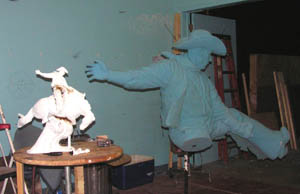
(Picture of the Ranger by Harold Holden maquette and enlarged urethane foam created by Synappsys Digital Services)
I visited Synappsys Digital Services to review the process and was thrilled with this new technology. I can’t wait to use it myself. Of course it is a bit of investment. The cost ranges from $1,500 to 4,000 for scanning and milling a 6-foot man depending on the detail and the density of foam used. They can even spray clay on the foam before shipping it to your studio. This process will save me so much time and money, I am definitely adding it to my repertoire of new resources. While preparing the article for Sculptural Review Magazine, I called many different vendors that offer this process. Here is a short list for your records. Prices can vary between vendors as well as the detail that can be obtained in the scanning and milling.
They say “necessity is the mother of invention”, and looking over this article I can see why. It is necessary that I create, and I love vendors that can assist in my creative process.
List of 3D resources
Digital Atelier, formerly Johnson Atelier
Cyber FX
Direct Dimensions specialize in scanning.
Satellite Model specializes in milling.
Digital stone project This company mills in stone.
All written work is copyrighted and cannot be used, whole or in part,
without the written consent of the author.
A Wonderful Opportunity! Some New Press, And a New Article
My recent article for Best of Artists has just been released. I loved interviewing Gary Staab. His work is incredible! Check out the article.
I have just seen the article for Sculptural Pursuit. The layout is great. They did a wonderful job.
I’m in Oklahoma right now doing some research on an article for Sculpture Review on technology. I am thrilled to be a part of this article and this magazine. I’ll be writing about Synappsys, and the technology involved with the creating of The American. The editor suggested I write the article in first person, which gives me the opportunity to have my own work in this very prestigious magazine.





